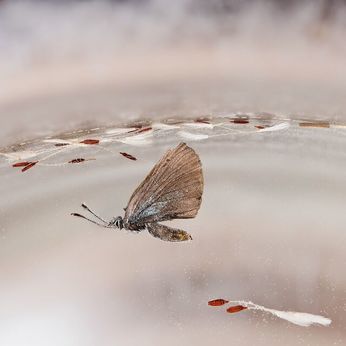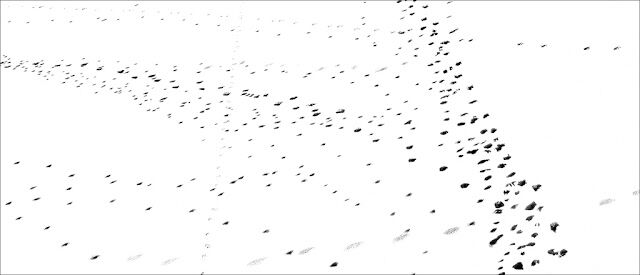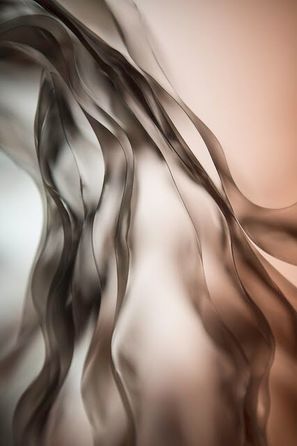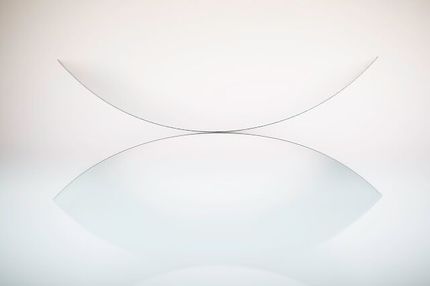 Death by Drowning, by Elizabeth Stone. Death by Drowning, by Elizabeth Stone. Brendan Dixon on Photographer Elizabeth Stone It was hot, and humid. I was playing the tourist. We were visiting friends in Virginia when our son was about a year old (meaning, many years ago) and they insisted on taking us to Colonial Williamsburg. Since my theme park experiences were all reduced to variations on Disneyland, I expected more of the same: History hung over a plastic frame. We were standing outside the Cooper’s (that is, the Barrel Maker’s) workshop: a medium-sized white building, more like a garage than a barn. A small wooden fence kept me at the safe tourist-distance, marking out his work area in front of the shop. The Cooper sat to the left, just within the shadows and out of the humid sun, on a three-legged stool (naturally) in white billowing sleeves and dark, grimy knickers. A leather apron hung from around his stooped neck spreading across his thighs. Against his apron rested a slat for his latest barrel. With a hand-held plane he peeled curling shavings from the slat. He intently watched each stroke of the plane. He rubbed the emerging edge with his hand between strokes, as if feeling his way forward. I began asking the normal, semi-snarky questions: How long have you done this? What do you do with the rest of your time? Is making barrels hard? And so on. But what I got back was not the snarky, here-is-my-response-to-an-obvious-tourist answer. I got something different. And what I got started my journey to rethink the things we’ve lost, what we should strive to keep, and what I would eventually learn about from Elizabeth Stone: Craft. I met Elizabeth Stone ten or so years after the Cooper, trying for craft to assuage my disaffection with work. She was in Seattle, along with her best friend, teaching a course offered through the Rocky Mountain School of Photography, where she would eventually spend eighteen years. I had been fumbling with digital cameras for about three or four years. My work was more miss than hit, and even my “hits” were never spot-on. They were lucky breaks, accidental works of near art. Disappointed, I took, what seemed to me the right next steps: I bought the proper equipment. I read a few books. And I signed up for the RMSP course. I believed that somehow out of my fresh set of Canon L-series lenses and the freedom to shoot for a week that elusive true art would emerge. I was partially right. Elizabeth grew up in a household filled with craft and immersed in art. Her journey began as the unexpected benefit of growing up frequently ill during her early elementary grades. “I was more often out of than in school.” She recounted to me about those couple of years, “I ended up doing a lot of crafts and drawing.” Her mother, who had worked and then volunteered for the Albany Institute of History and Art, cultivated Elizabeth’s endeavors. Her fascination focused as an early teen when her parents gave her, her first camera. Her high school classes increased her exposure to the medium through access to a large format camera, which she thought “was completely cool and exciting.” The darkroom, the chemicals, and the shooting process drew her in. But after high school Elizabeth struggled for direction. Her heart split: She loved animals and art. She vacillated between pursuing a biology degree or studying art at the Rhode Island School of Design. Art lost that first round. She started school at Trinity College in Hartford, but soon moved to Montana, graduating from Montana State University with a Wildlife Biology degree. Elizabeth told me “I see a lot of correlations between my science background and art, both have a love of observation, a skill that is pretty prevalent in both fields.” After college she went to work as a veterinary technician, married, divorced, and wound up evaluating her life. Art won this round. “I learned that I wanted photography to become my vocation,” she said looking back. She spent her savings on an RMSP summer intensive course, an eleven week immersion designed to jump start photography careers. She was hooked, but she still had a problem: There were few photography jobs under the big Montana sky. She then took a risk. She asked RMSP if they had any openings. That question created the fork in her road forward when they offered her an office position that soon led to teaching. It also led to me taking her class years later in Seattle. I remember sitting in her class, about ten years ago, taking detailed notes in my Moleskine (another required accoutrement, or so I thought). We talked about light and colour, form and balance. I learned how the frame creates its images. I jotted tables relating exposure to f/stops and light. But what I remember most were Elizabeth’s side-comments, as if I were her apprentice for a week. She explained patiently the need to see through the lens as I frowned over images, which, to my surprise, looked no better than those I had taken before her class. She encouraged me to experiment, to try things, to learn how my camera worked and behaved, to not fear all of its buttons and dials and settings. I remember standing shocked-still, gingerly holding that expensive camera and lens, as Elizabeth’s best friend described an experiment in which Elizabeth swung her camera in full circles with the shutter open just so she could see what it looked like and how it behaved. About midweek during the course we met early, around 7am, at the Pat Calvert Greenhouse. It’s located in the high part of Seattle’s Washington Park and overlooks downtown. After we’d been waiting for nearly an hour in the cold, when we were finally allowed inside, my camera lens had completely fogged over. I held the lens out to Elizabeth and growled. I felt frustrated. How could I photograph anything (and we had only an hour) with my lens a sloppy mess? She absorbed my grumblings without pause. She saw in my lens an opportunity, not an obstacle. “Shoot as the lens clears,” she said. She pushed me to see an advantage in what to me was a limitation, guiding me to see that art can emerge out of unlikely places. I took a breath and wound my way through the narrow walkways encroached by plants. My first few images showed nothing but indistinct blotches of muted color. But, trusting Elizabeth, I continued to try. As I did, images started to seep through the fog. They are not all works of high-art (I still bumbled about with composition and exposure), but some remain among my prized images. I learned then that the camera, like strings to a violinist, words to a writer, or ink to an illustrator, is a tool. I needed to know that tool, to become intimate with it. I had to feel, as the Cooper did, my way forward. Elizabeth saw the opportunity that day because of years invested in her art. She’s developed a voice that speaks through the abstract and the up-close. Perhaps the highest compliment I can pay her is simply this: Elizabeth sees. Her love for life and art entangle in her series, Death by Drowning, Lucy’s Water Bowl. Despite an intense fear of moths (rooted, she pondered, in a obscure bedtime story book), in her words, the “stunning” beauty of a dead moth floating in her dog’s cold, stainless steel bowl “demanded” attention. It grew into a habit of checking the bowl daily with camera in hand. But these are not iPhone quickies or moth selfies. Her composure gave dignity to that which most of us would dump and miss. She found the value in those small tragedies of life lost. By the mid-2000s, a couple of years after our class, Elizabeth had a good body of work, photographing everything she said from “weddings to animal portraits,” and had been a sought-after instructor at RMSP for years. Then life changed: she lost her much loved father in 2007. “That really shook me up,” she told me as we talked about her progression as an artist. “I took some time off and re-evaluated my life. I ended up with the idea of becoming an Artist-in-Residence and got encouragement with a National Park Service fellowship in 2010.” The fellowship gave Elizabeth three weeks to spend “thinking of nothing but photography.” “It transformed how I thought of myself as an artist,” she recalled. Those few weeks, spent at the Acadia National Park along the Maine coastline, proved pivotal. Elizabeth moved from building a body of successful images (as seen in her collection Pretty Pictures I Can’t Ignore) toward becoming a conceptual photographer. Instead of capturing images reactively, she started working towards them from a prior concept. Elizabeth then joined her two passions — her love of the animal world and photography — in the series Making Tracks. The work began during a 2011 artist residency at the Ucross Foundation in Clearmont, Wyoming. “At the time…I was reading ‘The Tiger’ by John Vaillant. Vaillant describes reading tracks as one of the earliest languages…I was drawn to their prints in snow or grass. They became the simplest form of the story of the animal’s existence.” Tracks are transient, ephemeral, yet, like the floating insects she honoured, give dignity and place to the animals that left them. Making Tracks draws on craft now instinctive from years of devotion. “I’m kind of a minimalist by nature,” Elizabeth noted. My notes from her instruction at the RMSP class reflect this: Use simple backgrounds. Focus on one thing. Light is the subject. She brings these together in Making Tracks through quietly composed monochromatic images that focus on line and balance, weighing carefully the space and frame. In them she snips from the living world a fragment of existence, the only fragment many of us can leave behind: the marks of their passage. A couple of years later, another concept spilled out of her files from years of image making. The accumulated slides crowded Elizabeth’s essentialist nature. Thousands of them overwhelmed her storage. Since she’d digitally scanned those that mattered, she launched on a new experiment. “I just got tired of all this stuff,” she reflected, so I “took them with me on this residency at The Jentel Foundation in Wyoming with literally no idea what I would do.” Instead of lighting them on fire (which she did consider) she sat alone in the wooden room and began, using her thumbnail, to pry and peel each slide apart. As she separated them into piles, against all training, she began touching her slides. “That was a whole new way of thinking about the images,” she said, “The process was freeing.” It became a project of taking her “past and thinking about it on a wholly different level.” She disassembled the slides into their essential parts, which she christened skins, shells, and meats. Next, without aim, she began piecing together free-standing sculptures lit only by a couple of light boxes whose hues had aged into blue-green and apricot. And then she embarked on image making. Those images — in the series Skins, Shells, and Meats — bring to my mind doors upon doors and windows receding into deepening blue. Others felt fluid, almost liquid with color and form. With these “remnants and bones” of her past, Elizabeth captured her own tracks through her transformation as an artist, the marks of her own passage. The lights dimmed at the close of our second class day. We sat around simple folding tables in a stark subterranean conference room of pale yellow walls at a Holiday Inn not far from Seattle’s Space Needle. I had sent my images to Elizabeth the night before. They were now on display for the entire class to see and, more concerning, for Elizabeth to critique. Looking at their projections I knew I had just pointed my lens and pressed the shutter button with no pause to see what had arrested my attention. Disappointed swelled. I squirmed. But Elizabeth remained encouraging, nurturing. I shifted and slumped in my seat as she explained not just why and how the image “did not work,” but what I could, and should do differently, next time to make one that did work. Over the remaining days, I crafted a few images, half-a-dozen at most, that I still look back at and smile over. They are not complete failures; they hold glimmers of beauty. Through Elizabeth’s guidance I caught a glimpse of craft. Elizabeth’s artistic shift resulted, not only in some of her best work, but also in recognition: In 2013 she won the PhotoNOLA Review Prize for her series Skins, Shells, and Meats and Making Tracks. Roy Flukinger, from The Harry Ransom Center, called her work in Making Tracks “lyrical, mystical, and symbolic.” The judges felt Elizabeth allowed the “animals who made these signs of passage an expressive voice.” Elizabeth embodies craft, even more than the Williamsburg Cooper who gave me that smack down years ago. Her persistent pursuit spans decades and tens-of-thousands of images. As she mused to me: “Being thoughtful takes time.” Not everyone may resonate with her abstract leanings, but Elizabeth has vision — a term unfulfilled as often as it is used. She sees the beauty buried in unlikely places and unexpected objects. And, isn’t that the purpose of photography? To show us that which we miss in our own hurried passings. Brendan Dixon Brendan Dixon is an avocational writer living in Seattle. He writes on art and life, or whatever topic strikes.
0 Comments
Your comment will be posted after it is approved.
Leave a Reply. |
The Ekphrastic Review
COOKIES/PRIVACY
This site uses cookies to deliver your best navigation experience this time and next. Continuing here means you consent to cookies. Thank you. Join us on Facebook:
July 2024
|






